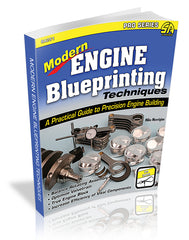Modern Engine Blueprinting Techniques: Required Information for Custom Piston
You need to do your home work and provide accurate specs, so the piston manufacturer produces the required piston. Most custom piston builders guide you through the process, and are able to handle any calculations that might be needed. Be sure to provide detailed and accurate information to get the piston you need.
Proper planning also is required before ordering a custom piston because you don’t want to make a mistake. After all, if you give the manufacturer the wrong information, you get an incorrect piston. The piston must be compatible and complementary with all the other internal parts. Lead or production time for a custom piston can vary greatly according to the time of year but common production time can be as little as three to five weeks but a wait of six to eight weeks or longer is possible. You need your new pistons before you perform a final hone of the bores because you must have the new pistons to measure skirt diameter. Ensure your cylinders clean-up straight at your new target bore size.
Find more stories like this in the book: MODERN ENGINE BLUEPRINTING TECHNIQUES
Learn about engine blueprinting. Get your copy here!
SHARE THIS ARTICLE: Please feel free to share this article on Facebook, in forums, or with any clubs yor participate in. You can copy and paste this link to share: https://www.cartechbooks.com/blogs/techtips/engine-blueprinting-computer-software
Here is the information you need to supply when ordering:
General Information
• Engine type (example: small-block Ford, LS1, big-block early-generation Chevy, 340 Mopar, etc.)
• Application (street, drag race, oval track, road race, marine, etc.)
• Desired compression ratio
• Estimated desired engine horsepower (an honest estimate)
• Maximum expected RPM
Crankshaft and Block
The piston manufacturer considers deck height, bore length, crank stroke, rod length, and crank counterweight radius. This is in part to make sure that the piston compression distance provides the desired compression ratio and deck clearance on the up-stroke, and also so that the piston skirt height clears the crank’s counterweights on the down-stroke.
• Block deck height (main bore center to deck surface)
• Finished bore size (target cylinder bore diameter)
• Cylinder bore length (bottom of cylinder wall to block deck)
• Distance between cylinder bores (center-to-center)
• Crank stroke
• Crankshaft counterweight radius (distance from crank centerline to outer edge of the counterweight)
Cylinder Head
This information is needed to help determine compression ratio and valve pocket placement, pocket radius, and depth and angles.
• Cylinder head (make, type, model, part number, casting number)
• Cylinder head chamber volume (ci)
• Valve diameters (intake and exhaust)
• Valve angles (if non-OEM)
• Compressed head gasket thickness
• Head gasket bore diameter (assume a round gasket bore)
• Head gasket volume (ci)
• Desired minimum valve-to-piston clearance
• Ring dimensions (axial height and radial width)
Connecting Rod
Rod information is needed to help determine piston compression height and distance between pin bosses. Information regarding rod material may be considered as well, due to the theoretical elongation of the rod length when using steel, aluminum, or titanium.
• Length (center-to-center)
• Material (steel, aluminum, titanium)
• Small-end width and thickness over the top of the pin hole
Camshaft and Valvetrain
The piston manufacturer considers actual valve movement off the seat to calculate the needed valve-to-piston clearance. Rod ratio plays a major part in piston-to-valve requirements, due to varying piston speeds at TDC for a given rod/stroke combination.
Camshaft Type
This is needed whether you have hydraulic, solid/flat-tappet, or roller cams.
• Gross valve lift (intake and exhaust)
• Lobe separation angle
• Cam duration at .050 inch
• Valve lift at piston TDC (intake and exhaust)
• Piston valve pocket depth (intake and exhaust, from sample piston, if available)
• Intake valve angle
• Valve spacing
Piston
• Pin support (floating or fixed)
• Skirt shape (scalloped, full round, inboard, etc.)
• Desired piston-to-deck clearance (–above or +below)
• Compression height (distance from pin center to theoretical “flat” of piston)
• Type (flat-top, conical-dish, dome, reverse-image dish, round dish, or full 3D max dome)
• Dome volume (total effective, including valve pockets)
• Axial ring height (top, second, oil)
• Radial ring width (top, second, oil)
• Desired ring back clearance, if not standard (top, second, oil)
• Wrist pin diameter
• Wrist pin length
• Pin wall thickness
Power Adders
This information helps the piston manufacturer to determine piston material, crown, cross-sectional thickness required for the power level desired, and piston-to-bore clearance.
• Maximum boost (turbo or supercharger)
• Nitrous HP amount
• Number of nitrous stages
• Fuel type and octane planned
Optional Piston Features
• Double pin oilers with slots (if not standard)
• Gas ports (side/top)
• Internal weight-removal milling
• Chamfer pins (round wire lock)
• Offset pins (OEM noise control)
• Ceramic top coat
• Moly skirt coat
• Casidium coated pins (race, dry sump, high-pan vacuum applications)

This is an example of how temperature and operating conditions can alter piston shape. At left, note larger deformation in the exhaust area. At right is an example of how temperature, inertia, pressure, and side force can result in shape changing during engine operation. (Illustration Courtesy Mahle Clevite)
Written by Mike Mavrigian and posted with permission of CarTech Books
Find more stories like this in the book: MODERN ENGINE BLUEPRINTING TECHNIQUES
Learn about engine blueprinting. Get your copy here!
SHARE THIS ARTICLE: Please feel free to share this article on Facebook, in forums, or with any clubs yor participate in. You can copy and paste this link to share: https://www.cartechbooks.com/blogs/techtips/engine-blueprinting-computer-software


